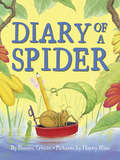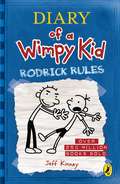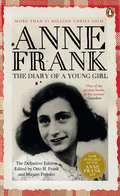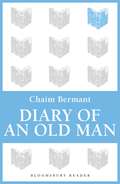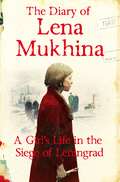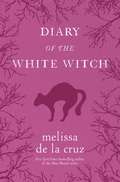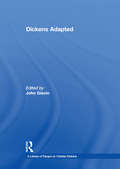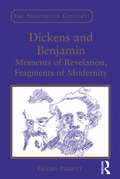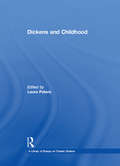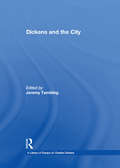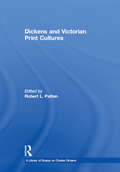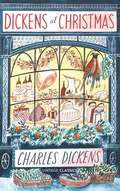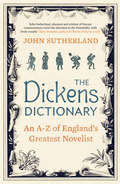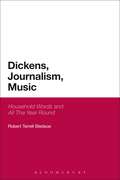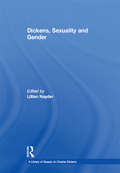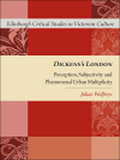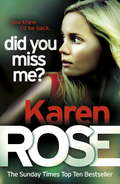- Table View
- List View
Diary of a Spider: Event Kit (Picture Book Readalong Ser.)
by Doreen CroninThis is the diary… of a spider. But don’t be worried – he’s more scared of you and your gigantic shoes than you will be of him! Actually he’s a lot like you. He goes to school and enjoys playing in the park. But he also spins sticky webs, scales walls and takes wind-catching lessons. And his best friend is a fly!
Diary of a Wimpy Kid: Rodrick Rules (Diary of a Wimpy Kid #2)
by Jeff KinneyIn the second book of Jeff Kinney's bestselling series, team up with Greg Heffley once again, this time to try and take on his big brother. As you can guess, it doesn't work out too well...Rodrick actually got a hold of my LAST journal a few weeks back, and it was a disaster. But don't even get me started on THAT story. Whatever you do, don't ask Greg about his summer vacation because he definitely doesn't want to talk about it!It's a brand-new year, with a brand-new journal and Greg is keen to put the humiliating (and secret!) events of last summer firmly behind him.But someone knows everything - someone whose job it is to most definitely not keep anything embarrassing of Greg's private - his big brother, Rodrick. How can Greg make it through this new school year with his not-quite-cool reputation intact?Even reluctant readers of 7+ will love diving into Greg's world, and reading about his exploits in his diary (sorry, journal!). Praise for Jeff Kinney and the Diary of a Wimpy Kid series:'The world has gone crazy for Jeff Kinney's Diary of a Wimpy Kid series' - The Sun'Kinney is right up there with J K Rowling as one of the bestselling children's authors on the planet'- Independent'Hilarious!' - Sunday Telegraphwww.wimpykidclub.co.uk
The Diary of a Young Girl: The Definitive Edition
by Anne FrankOne of the most famous accounts of living under the Nazi regime of World War II comes from the diary of a thirteen-year-old Jewish girl, Anne Frank. Today, The Diary of a Young Girl has sold over 25 million copies world-wide.It is one of the most celebrated and enduring books of the last century and it remains a deeply admired testament to the indestructible nature of human spirit.Anne Frank and her family fled the horrors of Nazi occupation by hiding in the back of a warehouse in Amsterdam for two years with another family and a German dentist. Aged thirteen when she went into the secret annexe, Anne kept a diary. She movingly revealed how the eight people living under these extraordinary conditions coped with hunger, the daily threat of discovery and death and being cut off from the outside world, as well as petty misunderstandings and the unbearable strain of living like prisoners.The Diary of a Yong Girl is a timeless true story to be rediscovered by each new generation. For young readers and adults it continues to bring to life Anne's extraordinary courage and struggle throughout her ordeal.'One of the greatest books of the century' Guardian'A modern classic' The Times'Rings down the decades as the most moving testament to the persecution of innocence' Daily Mail'Astonishing and excruciating. Its gnaws at us still' New York Times Book ReviewAnne Frank was born on 12 June 1929. She died in Bergen-Belsen, three months short of her sixteenth birthday.
Diary of an Old Man
by Chaim Bermant"Yes," as Cyril might say, "being old's all right, once you get past the age of trying to be young." First published in 1966, Diary of an old man is a real tour de force. It covers one winter month in the life of an old man living in a tiny pension. The prosaic events which are recounted - keeping warm, finding accommodation, cooking, reading papers in the local library - conceal an extraordinary feat of imagination on the part of the author: Mr. Bermant's concept of Cyril, his narrator, is so complete that this book is not only intensely moving, but is also a real contribution to an understanding of the human condition. It has become costumary for a sociologist to speak of "the problem of old age"; but until the "problem" is accepted subjectively, by individuals, it is an empty phrase. In this very unusual, often very funny book, Mr. Bermant strips the reader of all illusions, and shows just what it is to be old, and poor, and friendless, and yet not to lose a sense of humour or the will to live.
The Diary of Lena Mukhina: A Girl's Life in the Siege of Leningrad
by Lena MukhinaIn May 1941 Lena Mukhina was an ordinary teenage girl, living in Leningrad, worrying about her homework and whether Vova - the boy she liked - liked her. Like a good Soviet schoolgirl, she was also diligently learning German, the language of Russia's Nazi ally. And she was keeping a diary, in which she recorded her hopes and dreams. Then, on 22 June 1941, Hitler broke his pact with Stalin and declared war on the Soviet Union. All too soon, Leningrad was besieged and life became a living hell. Lena and her family fought to stay alive; their city was starving and its citizens were dying in their hundreds of thousands. From day to dreadful day, Lena records her experiences: the desperate hunt for food, the bitter cold of the Russian winter and the cruel deaths of those she loved. A truly remarkable account of this most terrible era in modern history, The Diary of Lena Mukhina is the vivid first-hand testimony of a courageous young woman struggling simply to survive.
Diary of the White Witch: A Witches of East End Prequel
by Melissa de la CruzThe exciting prequel to the Witches of East End series from Blue Bloods author, Melissa de la Cruz.
Diary of the White Witch: A Witches of East End Prequel
by Melissa de la CruzThe exciting prequel to the Witches of East End series from Blue Bloods author, Melissa de la Cruz.
Dickens Adapted (A Library of Essays on Charles Dickens)
by John GlavinFrom their first appearance in print, Dickens's fictions immediately migrated into other media, and particularly, in his own time, to the stage. Since then Dickens has continuously, apparently inexhaustibly, functioned as the wellspring for a robust mini-industry, sourcing plays, films, television specials and series, operas, new novels and even miniature and model villages. If in his lifetime he was justly called 'The Inimitable', since his death he has become just the reverse: the Infinitely Imitable. The essays in this volume, all appearing within the past twenty years, cover the full spectrum of genres. Their major shared claim to attention is their break from earlier mimetic criteria - does the film follow the novel? - to take the new works seriously within their own generic and historical contexts. Collectively, they reveal an entirely 'other' Dickensian oeuvre, which ironically has perhaps made Dickens better known to an audience of non-readers than to those who know the books themselves.
Dickens Adapted (A Library of Essays on Charles Dickens)
by John GlavinFrom their first appearance in print, Dickens's fictions immediately migrated into other media, and particularly, in his own time, to the stage. Since then Dickens has continuously, apparently inexhaustibly, functioned as the wellspring for a robust mini-industry, sourcing plays, films, television specials and series, operas, new novels and even miniature and model villages. If in his lifetime he was justly called 'The Inimitable', since his death he has become just the reverse: the Infinitely Imitable. The essays in this volume, all appearing within the past twenty years, cover the full spectrum of genres. Their major shared claim to attention is their break from earlier mimetic criteria - does the film follow the novel? - to take the new works seriously within their own generic and historical contexts. Collectively, they reveal an entirely 'other' Dickensian oeuvre, which ironically has perhaps made Dickens better known to an audience of non-readers than to those who know the books themselves.
Dickens and Benjamin: Moments of Revelation, Fragments of Modernity
by Gillian PiggottPlacing the works of Charles Dickens and Walter Benjamin in conversation with one another, Gillian Piggott argues that the two writers display a shared vision of modernity. Her analysis of their works shows that both writers demonstrate a decreased confidence in the capacity to experience truth or religious meaning in an increasingly materialist world and that both occupy similar positions towards urban modernity and its effect upon experience. Piggott juxtaposes her exploration of Benjamin's ideas on allegory and messianism with an examination of Dickens's The Old Curiosity Shop, arguing that both writers proffer a melancholy vision of a world devoid of space and time for religious experience, a state of affairs they associate with the onset of industrial capitalism. In Benjamin's The Arcades Project and Dickens's Sketches by Boz and Tale of Two Cities, among other works, the authors converge in their hugely influential treatments of the city as a site of perambulation, creativity, memory, and autobiography. At the same time, both authors relate to the vertiginous, mutable, fast-paced nature of city life as involving a concomitant change in the structure of experience, an alteration that can be understood as a reduction in the capacity to experience fully. Piggott's persuasive analyses enable a reading of Dickens as part of a European, particularly a German, tradition of thinkers and writers of industrialization and modernity. For both Dickens and Benjamin, truth appears only in moments of revelation, in fragments of modernity.
Dickens and Benjamin: Moments of Revelation, Fragments of Modernity
by Gillian PiggottPlacing the works of Charles Dickens and Walter Benjamin in conversation with one another, Gillian Piggott argues that the two writers display a shared vision of modernity. Her analysis of their works shows that both writers demonstrate a decreased confidence in the capacity to experience truth or religious meaning in an increasingly materialist world and that both occupy similar positions towards urban modernity and its effect upon experience. Piggott juxtaposes her exploration of Benjamin's ideas on allegory and messianism with an examination of Dickens's The Old Curiosity Shop, arguing that both writers proffer a melancholy vision of a world devoid of space and time for religious experience, a state of affairs they associate with the onset of industrial capitalism. In Benjamin's The Arcades Project and Dickens's Sketches by Boz and Tale of Two Cities, among other works, the authors converge in their hugely influential treatments of the city as a site of perambulation, creativity, memory, and autobiography. At the same time, both authors relate to the vertiginous, mutable, fast-paced nature of city life as involving a concomitant change in the structure of experience, an alteration that can be understood as a reduction in the capacity to experience fully. Piggott's persuasive analyses enable a reading of Dickens as part of a European, particularly a German, tradition of thinkers and writers of industrialization and modernity. For both Dickens and Benjamin, truth appears only in moments of revelation, in fragments of modernity.
Dickens and Childhood (A Library of Essays on Charles Dickens)
by Laura Peters'No words can express the secret agony of my soul'. Dickens's tantalising hint alluding to his time at Warren's Blacking Factory remains a gnomic statement until Forster's biography after Dickens's death. Such a revelation partly explains the dominance of biography in early Dickens criticism; Dickens's own childhood was understood to provide the material for his writing, particularly his representation of the child and childhood. Yet childhood in Dickens continues to generate a significant level of critical interest. This volume of essays traces the shifting importance given to childhood in Dickens criticism. The essays consider a range of subjects such as the Romantic child, the child and the family, and the child as a vehicle for social criticism, as well as current issues such as empire, race and difference, and death. Written by leading researchers and educators, this selection of previously published articles and book chapters is representative of key developments in this field. Given the perennial importance of the child in Dickens this volume is an indispensable reference work for Dickens specialists and aficionados alike.
Dickens and Childhood (A Library of Essays on Charles Dickens)
by Laura Peters'No words can express the secret agony of my soul'. Dickens's tantalising hint alluding to his time at Warren's Blacking Factory remains a gnomic statement until Forster's biography after Dickens's death. Such a revelation partly explains the dominance of biography in early Dickens criticism; Dickens's own childhood was understood to provide the material for his writing, particularly his representation of the child and childhood. Yet childhood in Dickens continues to generate a significant level of critical interest. This volume of essays traces the shifting importance given to childhood in Dickens criticism. The essays consider a range of subjects such as the Romantic child, the child and the family, and the child as a vehicle for social criticism, as well as current issues such as empire, race and difference, and death. Written by leading researchers and educators, this selection of previously published articles and book chapters is representative of key developments in this field. Given the perennial importance of the child in Dickens this volume is an indispensable reference work for Dickens specialists and aficionados alike.
Dickens and the City (A Library of Essays on Charles Dickens)
by Jeremy TamblingDickens's relationship to cities is part of his modernity and his enduring fascination. How he thought about, grasped and conceptualised the rapidly expanding and anonymous urban scene are all fascinating aspects of a critical debate which, starting virtually from Dickens's own time, has become more and more active and questioning of the significance of that new thing, the unknown and unknowable, city. Although Dickens was influenced by several European and American cities, the most significant city for Dickens was London, the city he knew as a boy in the 1820s and which developed in his lifetime to become the finance and imperial capital of the nineteenth-century. His sense of London as monumental and fashionable, modern and anachronistic, has generated a large number of writings and critical approaches: Marxist, sociological, psychoanalytic and deconstructive. Dickens looks at the city from several aspects: as a place bringing together poverty and riches; as the place of the new and of chance and coincidence, and of secret lives exposed by the special figure of the detective. Another crucial area of study is the relationship of the city to women, and women's place in the city, as well as the way Dickens's London matches up with other visual representations. This anthology of criticism surveys the field and is a major contribution to the study of cities, city culture, modernity and Dickens. It brings together key previously published articles and essays and features a comprehensive bibliography of work which scholars can continue to explore.
Dickens and the City: Allegory And Literature Of The City (A Library of Essays on Charles Dickens)
by Jeremy TamblingDickens's relationship to cities is part of his modernity and his enduring fascination. How he thought about, grasped and conceptualised the rapidly expanding and anonymous urban scene are all fascinating aspects of a critical debate which, starting virtually from Dickens's own time, has become more and more active and questioning of the significance of that new thing, the unknown and unknowable, city. Although Dickens was influenced by several European and American cities, the most significant city for Dickens was London, the city he knew as a boy in the 1820s and which developed in his lifetime to become the finance and imperial capital of the nineteenth-century. His sense of London as monumental and fashionable, modern and anachronistic, has generated a large number of writings and critical approaches: Marxist, sociological, psychoanalytic and deconstructive. Dickens looks at the city from several aspects: as a place bringing together poverty and riches; as the place of the new and of chance and coincidence, and of secret lives exposed by the special figure of the detective. Another crucial area of study is the relationship of the city to women, and women's place in the city, as well as the way Dickens's London matches up with other visual representations. This anthology of criticism surveys the field and is a major contribution to the study of cities, city culture, modernity and Dickens. It brings together key previously published articles and essays and features a comprehensive bibliography of work which scholars can continue to explore.
Dickens and Victorian Print Cultures (A Library of Essays on Charles Dickens)
by Robert L. PattenThis volume places Dickens at the centre of a dynamic and expanding Victorian print world and tells the story of his career against a background of options available to him. The collection describes a world animated by outpourings of print materials: books, serials, newspapers, periodicals, libraries, paintings and prints, parodies and plagiarisms, censorship, advertising, as well as theatre and other entertainment, and celebrity. It also shows this period as driven by a growing and more literate population, and undergirded by a general conviction that writing was a crucial component of governance and civic culture. The extensive introduction and selected articles anchor Dickens's attempts to establish better conditions for writers regarding copyright protection, pay, status, recognition, and effectiveness in altering public policy. They speak about Dickens's life as playwright, journalist, novelist, editor, magazine publisher, theatrical producer, actor, lecturer, reader of his own works, supporter of charities for impoverished authors and fallen women, exponent of a morality of Christian compassion and domestic affections sometimes put into question by his own actions, proponent and critic of British nationalism, and champion of education for all. This selection of essays and articles from previously published accounts by internationally renowned scholars is of interest to all students and professionals who are fascinated by the composition, manufacture, finance, formats, pictorializations, sales, advertising and influence of Dickens's writing.
Dickens and Victorian Print Cultures (A Library of Essays on Charles Dickens)
by Robert L. PattenThis volume places Dickens at the centre of a dynamic and expanding Victorian print world and tells the story of his career against a background of options available to him. The collection describes a world animated by outpourings of print materials: books, serials, newspapers, periodicals, libraries, paintings and prints, parodies and plagiarisms, censorship, advertising, as well as theatre and other entertainment, and celebrity. It also shows this period as driven by a growing and more literate population, and undergirded by a general conviction that writing was a crucial component of governance and civic culture. The extensive introduction and selected articles anchor Dickens's attempts to establish better conditions for writers regarding copyright protection, pay, status, recognition, and effectiveness in altering public policy. They speak about Dickens's life as playwright, journalist, novelist, editor, magazine publisher, theatrical producer, actor, lecturer, reader of his own works, supporter of charities for impoverished authors and fallen women, exponent of a morality of Christian compassion and domestic affections sometimes put into question by his own actions, proponent and critic of British nationalism, and champion of education for all. This selection of essays and articles from previously published accounts by internationally renowned scholars is of interest to all students and professionals who are fascinated by the composition, manufacture, finance, formats, pictorializations, sales, advertising and influence of Dickens's writing.
Dickens at Christmas: Vintage Christmas (Vintage Christmas Ser.)
by Charles DickensIt is said that Charles Dickens invented Christmas, and within these pages you'll certainly find all the elements of a quintessential traditional Christmas brought to vivid life: snowy rooftops, gleaming shop windows, steaming bowls of punch, plum puddings like speckled cannon balls, sage and onion stuffing, miracles, magic, charity and goodwill. This beautifully produced Vintage Classics edition gathers together not only Dickens' Christmas Books ('A Christmas Carol', 'The Chimes', 'The Battle of Life','The Cricket on the Hearth' and 'The Haunted Man') but also stories that Dickens wrote for the special seasonal editions of his periodicals All the Year Round and Household Words, and a festive tale from The Pickwick Papers. A must-have for Christmas, this edition should be as necessary to your festivities as holly, mistletoe and silver bells.
The Dickens Dictionary: An A-Z of Britain's Greatest Novelist
by John SutherlandFor fans new and old, an enjoyable tour through the world of Dickens in the hands of a master critic. Charles Dickens, the 'Great Inimitable', created a riotous fictional world that still lives and breathes for thousands of readers today. But how much do we really know about the dazzling imagination that brought all this into being? For the bicentenary of Dickens' birth, Victorian literature expert John Sutherland has created a gloriously wide-ranging alphabetical companion to Dickens' work, excavating the hidden links between his characters, themes, and preoccupations, and the minutiae of his endlessly inventive wordplay. Covering America, Bastards, Childhood, Christmas, Empire, Fog, Larks, London, Madness, Murder, Orphans, Pubs, Punishment, Smells, Spontaneous Combustion and Zoo to name but a few - John Sutherland gives us a uniquely personal guide to the great man's work. Excerpt: HANDS; Every Dickens novel has a master image. In Our Mutual Friend it is the river. In Bleak House it is the fog. In Little Dorrit, it is the prison. In Great Expectations it is the hand. We often know much more about the principals' hands in that novel than their faces. Who, when the name Magwitch is mentioned, does not think of those murderous 'large brown veinous hands'? Jaggers? One's nose twitches---scented soap (the lawyer, like Pontius Pilate, is forever washing his hands). Miss Havisham? Withered claws. So it goes on...
Dickens, Journalism, Music: 'Household Words' and 'All The Year Round' (Continuum Literary Studies)
by Robert Terrell BledsoeDickens, Journalism, Music presents the first full analysis of the articles on music published in the two journals conducted by Charles Dickens, Household Words and its successor, All the Year Round. Robert Bledsoe examines the editorial influence of Dickens on articles written by a range of writers and what it reveals about his own developing attitude to music and its social role in parks, community singing groups, music halls and on the streets. The book also looks at the difference between the two journals and how the greater coverage of classical music and opera in All the Year Round reflects the increasing importance of music to Dickens in his later life.
Dickens, Journalism, Music: 'Household Words' and 'All The Year Round' (Continuum Literary Studies)
by Robert Terrell BledsoeDickens, Journalism, Music presents the first full analysis of the articles on music published in the two journals conducted by Charles Dickens, Household Words and its successor, All the Year Round. Robert Bledsoe examines the editorial influence of Dickens on articles written by a range of writers and what it reveals about his own developing attitude to music and its social role in parks, community singing groups, music halls and on the streets. The book also looks at the difference between the two journals and how the greater coverage of classical music and opera in All the Year Round reflects the increasing importance of music to Dickens in his later life.
Dickens, Sexuality and Gender (A Library of Essays on Charles Dickens)
by Lillian NayderThis volume of essays examines Dickens's complex representations of sexuality and gender as well as his use of gender ideologies and sexual and gender differences over the course of his literary career, from his first sketches and early novels to his late works of fiction. The essays approach gender issues in Dickens's writing by focusing on a number of topics: his treatment of gender ideals and transgressions; the intersections and displacements among gender, class and race; the ties between gender and the body, and among gender, voice and language; his depiction of the homosocial and the homoerotic; and the relation between gender and the law. The essays provide an introduction to the most recent approaches to Dickens's fiction in addition to those now considered classic, draw on queer theory and also feature a variety of methodologies, ranging across feminist, historicist and psychoanalytic methods of interpretation. The collection represents the best of previously published research by Dickens's scholars and illuminates for students and scholars alike the meaning of gender in such novels as The Pickwick Papers, Dombey and Son, and Our Mutual Friend.
Dickens, Sexuality and Gender (A Library of Essays on Charles Dickens)
by Lillian NayderThis volume of essays examines Dickens's complex representations of sexuality and gender as well as his use of gender ideologies and sexual and gender differences over the course of his literary career, from his first sketches and early novels to his late works of fiction. The essays approach gender issues in Dickens's writing by focusing on a number of topics: his treatment of gender ideals and transgressions; the intersections and displacements among gender, class and race; the ties between gender and the body, and among gender, voice and language; his depiction of the homosocial and the homoerotic; and the relation between gender and the law. The essays provide an introduction to the most recent approaches to Dickens's fiction in addition to those now considered classic, draw on queer theory and also feature a variety of methodologies, ranging across feminist, historicist and psychoanalytic methods of interpretation. The collection represents the best of previously published research by Dickens's scholars and illuminates for students and scholars alike the meaning of gender in such novels as The Pickwick Papers, Dombey and Son, and Our Mutual Friend.
Dickens's London: Perception, Subjectivity and Phenomenal Urban Multiplicity (Edinburgh Critical Studies in Victorian Culture (PDF))
by Julian WolfreysThis phenomenological exploration of the streets of Dickens's London opens up new perspectives on the city and the writer.Taking Walter Benjamin's Arcades Project as an inspiration, Dickens's London offers an exciting and original project that opens a dialogue between phenomenology, philosophy and the Dickensian representation of the city in all its forms. Julian Wolfreys suggests that in their representations of London - its streets, buildings, public institutions, domestic residences, rooms and phenomena that constitute such space - Dickens's novels and journalism can be seen as forerunners of urban and material phenomenology. While also addressing those aspects of the urban that are developed from Dickens's interpretations of other literary forms, styles and genres, Dickens's London presents in twenty-six episodes (from Banking and Breakfast via the Insolvent Court, Melancholy and Poverty, to Todgers and Time, Voice and Waking) a radical reorientation to London in the nineteenth century, the development of Dickens as a writer, and the ways in which readers today receive and perceive both.Key Features* Major reassessment of Dickens's writing on the city * Dual focus on methodology and the historicity of Dickensian urban consciousness* Philosophical reflections on urban tropologies through key passages from Dickens's texts recreate the experience of Victorian London * Inventive structure offers the reader an experience of the disordered multiplicity of London* Illustrated with 19 maps and photographs
Did You Miss Me? (Baltimore Series #3)
by Karen RoseBest be nimble, best be quick, I'm right here and you're my pick: DID YOU MISS ME is a page-turning thriller from bestselling author Karen Rose, and part of the Baltimore series. The last thing Ford Elkhart remembers is walking his girlfriend back to her university dormitory. Now he's lying tied and gagged on a cold, dark floor, with only one chance to escape before he ends up like the bones surrounding him... Assistant State's Attorney Daphne Montgomery is devastated by her son's disappearance, and is immediately convinced that his kidnapping is connected to the white supremacist she's just had jailed for murder. FBI Special Agent Joseph Carter isn't so sure - especially when he learns that Ford's girlfriend is also missing. Is Ford's abduction payback for Daphne's courtroom victory? Or is he a pawn in an even more dangerous game?
